Leadership Approaches, Motivation, and Commitment: BMAL 501 Report
VerifiedAdded on 2022/08/14
|18
|4182
|14
Report
AI Summary
This report presents an annotated bibliography and literature review outline focusing on the roles of democratic, situational, and transformational leadership approaches in motivating employees. The annotated bibliography comprises 15 peer-reviewed articles, each summarized, analyzed for relevance, and reflected upon in terms of its contribution to the research. The literature review outline organizes the key themes derived from these articles, including the value of democratic leadership in fostering equality, the importance of situational leaders adapting to specific needs, and the encouragement provided by transformational leaders to embrace change. The outline provides a structured framework for the literature review, incorporating detailed points and direct quotes from the selected articles to support arguments about the strengths and weaknesses of each leadership approach. The research aims to compare the effectiveness of these leadership styles in achieving employee motivation and organizational success. The report provides a comprehensive overview of leadership theories and strategies designed to enhance workforce performance and commitment.
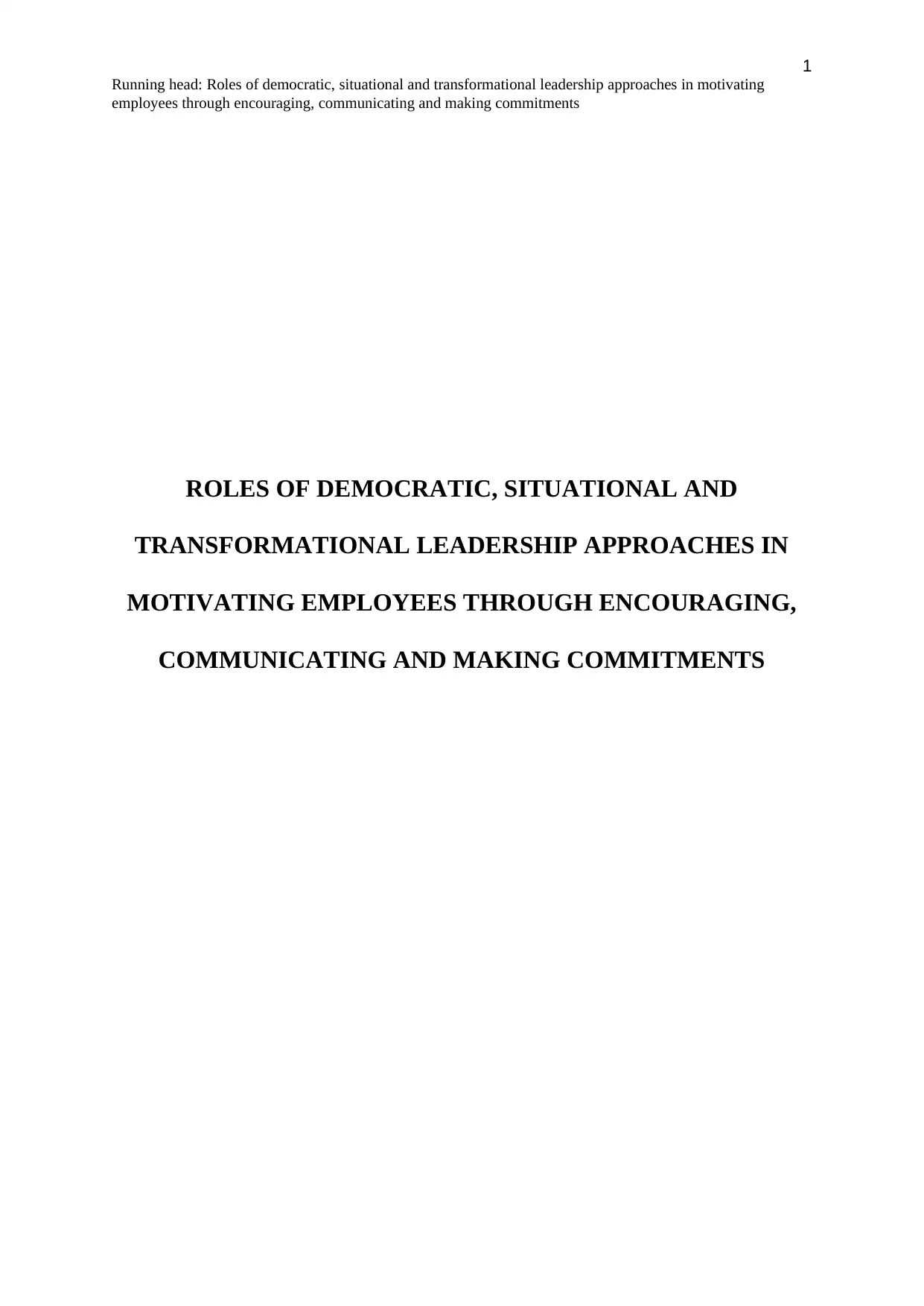
1
Running head: Roles of democratic, situational and transformational leadership approaches in motivating
employees through encouraging, communicating and making commitments
ROLES OF DEMOCRATIC, SITUATIONAL AND
TRANSFORMATIONAL LEADERSHIP APPROACHES IN
MOTIVATING EMPLOYEES THROUGH ENCOURAGING,
COMMUNICATING AND MAKING COMMITMENTS
Running head: Roles of democratic, situational and transformational leadership approaches in motivating
employees through encouraging, communicating and making commitments
ROLES OF DEMOCRATIC, SITUATIONAL AND
TRANSFORMATIONAL LEADERSHIP APPROACHES IN
MOTIVATING EMPLOYEES THROUGH ENCOURAGING,
COMMUNICATING AND MAKING COMMITMENTS
Paraphrase This Document
Need a fresh take? Get an instant paraphrase of this document with our AI Paraphraser
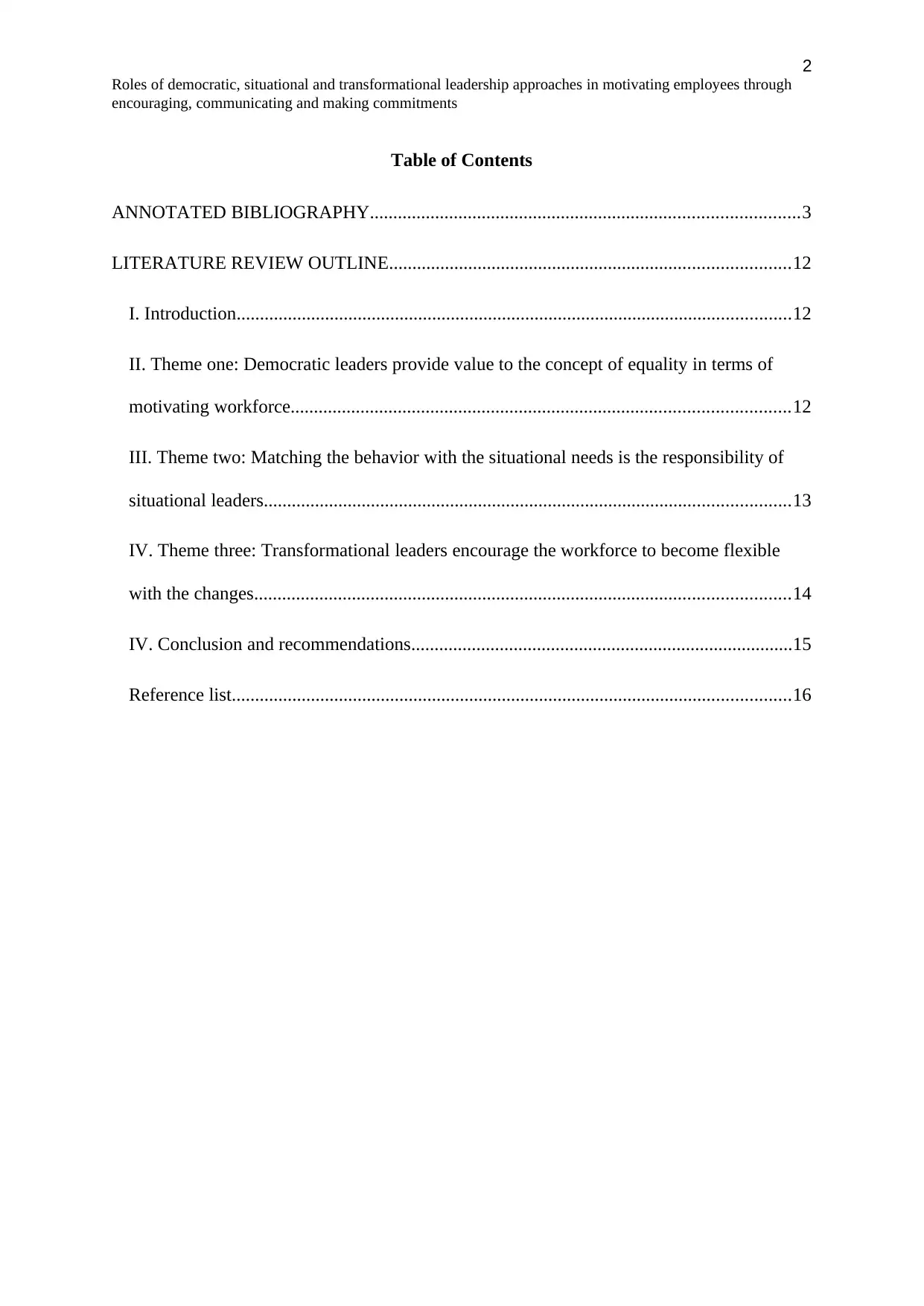
2
Roles of democratic, situational and transformational leadership approaches in motivating employees through
encouraging, communicating and making commitments
Table of Contents
ANNOTATED BIBLIOGRAPHY............................................................................................3
LITERATURE REVIEW OUTLINE......................................................................................12
I. Introduction.......................................................................................................................12
II. Theme one: Democratic leaders provide value to the concept of equality in terms of
motivating workforce...........................................................................................................12
III. Theme two: Matching the behavior with the situational needs is the responsibility of
situational leaders.................................................................................................................13
IV. Theme three: Transformational leaders encourage the workforce to become flexible
with the changes...................................................................................................................14
IV. Conclusion and recommendations..................................................................................15
Reference list........................................................................................................................16
Roles of democratic, situational and transformational leadership approaches in motivating employees through
encouraging, communicating and making commitments
Table of Contents
ANNOTATED BIBLIOGRAPHY............................................................................................3
LITERATURE REVIEW OUTLINE......................................................................................12
I. Introduction.......................................................................................................................12
II. Theme one: Democratic leaders provide value to the concept of equality in terms of
motivating workforce...........................................................................................................12
III. Theme two: Matching the behavior with the situational needs is the responsibility of
situational leaders.................................................................................................................13
IV. Theme three: Transformational leaders encourage the workforce to become flexible
with the changes...................................................................................................................14
IV. Conclusion and recommendations..................................................................................15
Reference list........................................................................................................................16
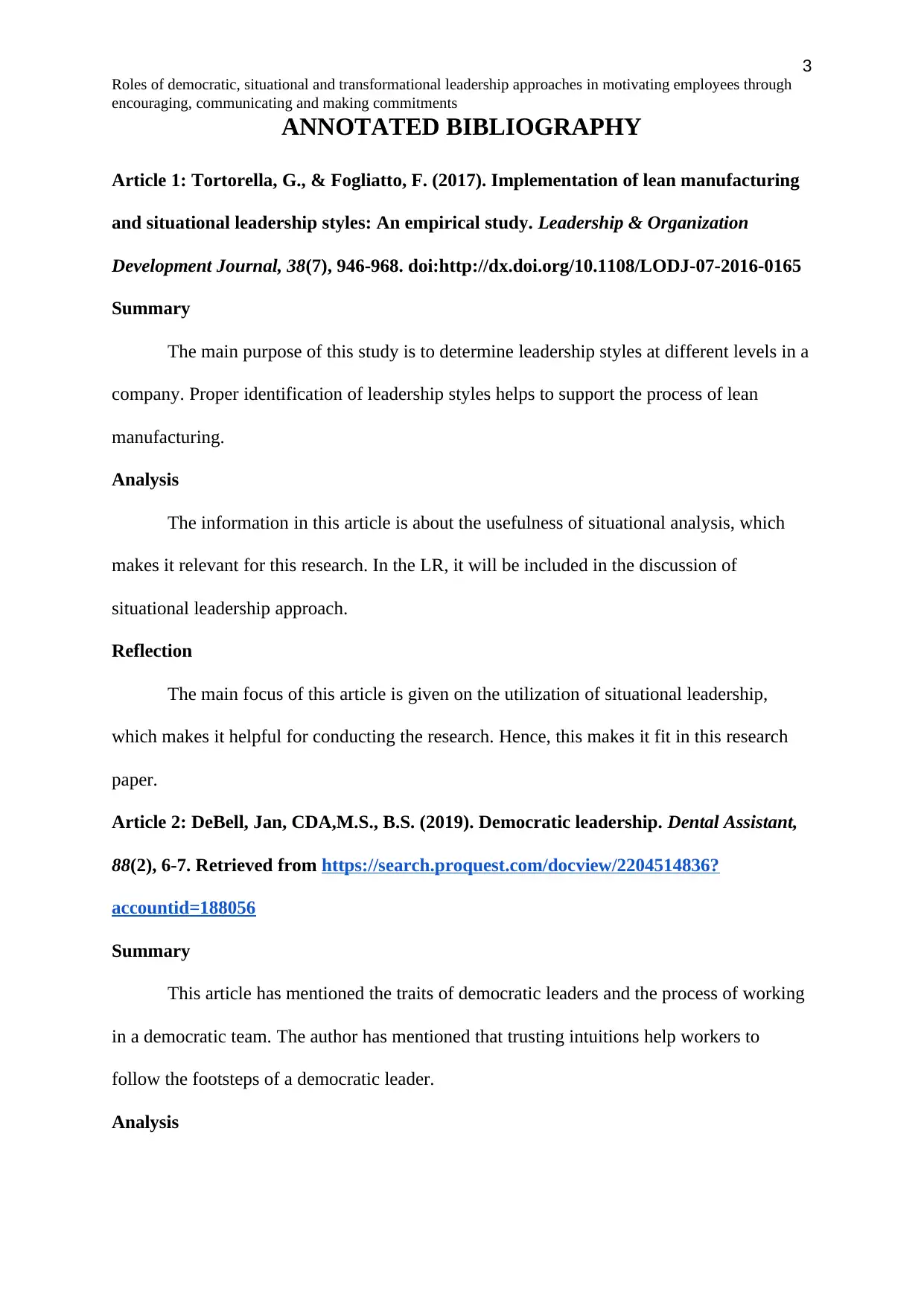
3
Roles of democratic, situational and transformational leadership approaches in motivating employees through
encouraging, communicating and making commitments
ANNOTATED BIBLIOGRAPHY
Article 1: Tortorella, G., & Fogliatto, F. (2017). Implementation of lean manufacturing
and situational leadership styles: An empirical study. Leadership & Organization
Development Journal, 38(7), 946-968. doi:http://dx.doi.org/10.1108/LODJ-07-2016-0165
Summary
The main purpose of this study is to determine leadership styles at different levels in a
company. Proper identification of leadership styles helps to support the process of lean
manufacturing.
Analysis
The information in this article is about the usefulness of situational analysis, which
makes it relevant for this research. In the LR, it will be included in the discussion of
situational leadership approach.
Reflection
The main focus of this article is given on the utilization of situational leadership,
which makes it helpful for conducting the research. Hence, this makes it fit in this research
paper.
Article 2: DeBell, Jan, CDA,M.S., B.S. (2019). Democratic leadership. Dental Assistant,
88(2), 6-7. Retrieved from https://search.proquest.com/docview/2204514836?
accountid=188056
Summary
This article has mentioned the traits of democratic leaders and the process of working
in a democratic team. The author has mentioned that trusting intuitions help workers to
follow the footsteps of a democratic leader.
Analysis
Roles of democratic, situational and transformational leadership approaches in motivating employees through
encouraging, communicating and making commitments
ANNOTATED BIBLIOGRAPHY
Article 1: Tortorella, G., & Fogliatto, F. (2017). Implementation of lean manufacturing
and situational leadership styles: An empirical study. Leadership & Organization
Development Journal, 38(7), 946-968. doi:http://dx.doi.org/10.1108/LODJ-07-2016-0165
Summary
The main purpose of this study is to determine leadership styles at different levels in a
company. Proper identification of leadership styles helps to support the process of lean
manufacturing.
Analysis
The information in this article is about the usefulness of situational analysis, which
makes it relevant for this research. In the LR, it will be included in the discussion of
situational leadership approach.
Reflection
The main focus of this article is given on the utilization of situational leadership,
which makes it helpful for conducting the research. Hence, this makes it fit in this research
paper.
Article 2: DeBell, Jan, CDA,M.S., B.S. (2019). Democratic leadership. Dental Assistant,
88(2), 6-7. Retrieved from https://search.proquest.com/docview/2204514836?
accountid=188056
Summary
This article has mentioned the traits of democratic leaders and the process of working
in a democratic team. The author has mentioned that trusting intuitions help workers to
follow the footsteps of a democratic leader.
Analysis
⊘ This is a preview!⊘
Do you want full access?
Subscribe today to unlock all pages.

Trusted by 1+ million students worldwide
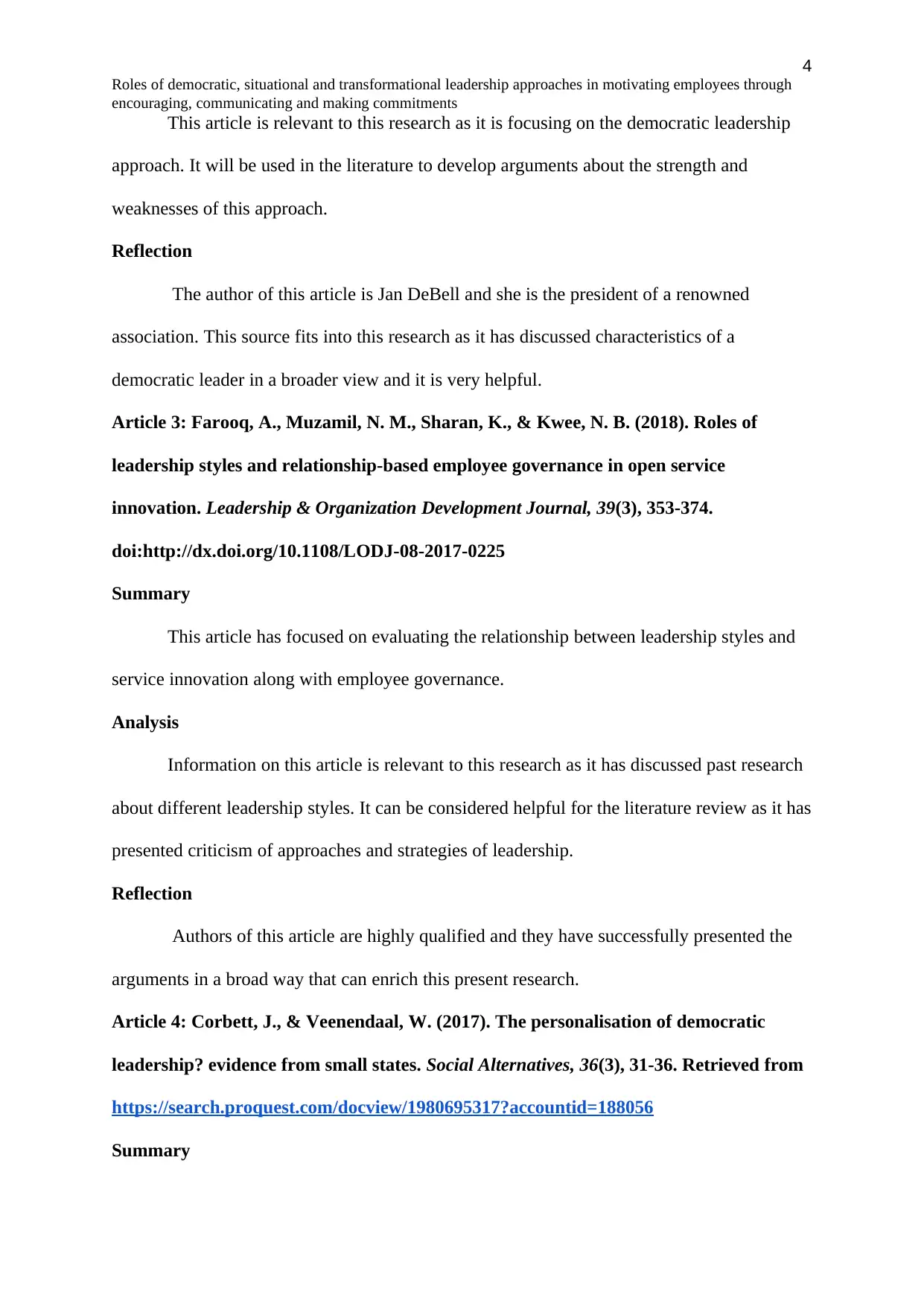
4
Roles of democratic, situational and transformational leadership approaches in motivating employees through
encouraging, communicating and making commitments
This article is relevant to this research as it is focusing on the democratic leadership
approach. It will be used in the literature to develop arguments about the strength and
weaknesses of this approach.
Reflection
The author of this article is Jan DeBell and she is the president of a renowned
association. This source fits into this research as it has discussed characteristics of a
democratic leader in a broader view and it is very helpful.
Article 3: Farooq, A., Muzamil, N. M., Sharan, K., & Kwee, N. B. (2018). Roles of
leadership styles and relationship-based employee governance in open service
innovation. Leadership & Organization Development Journal, 39(3), 353-374.
doi:http://dx.doi.org/10.1108/LODJ-08-2017-0225
Summary
This article has focused on evaluating the relationship between leadership styles and
service innovation along with employee governance.
Analysis
Information on this article is relevant to this research as it has discussed past research
about different leadership styles. It can be considered helpful for the literature review as it has
presented criticism of approaches and strategies of leadership.
Reflection
Authors of this article are highly qualified and they have successfully presented the
arguments in a broad way that can enrich this present research.
Article 4: Corbett, J., & Veenendaal, W. (2017). The personalisation of democratic
leadership? evidence from small states. Social Alternatives, 36(3), 31-36. Retrieved from
https://search.proquest.com/docview/1980695317?accountid=188056
Summary
Roles of democratic, situational and transformational leadership approaches in motivating employees through
encouraging, communicating and making commitments
This article is relevant to this research as it is focusing on the democratic leadership
approach. It will be used in the literature to develop arguments about the strength and
weaknesses of this approach.
Reflection
The author of this article is Jan DeBell and she is the president of a renowned
association. This source fits into this research as it has discussed characteristics of a
democratic leader in a broader view and it is very helpful.
Article 3: Farooq, A., Muzamil, N. M., Sharan, K., & Kwee, N. B. (2018). Roles of
leadership styles and relationship-based employee governance in open service
innovation. Leadership & Organization Development Journal, 39(3), 353-374.
doi:http://dx.doi.org/10.1108/LODJ-08-2017-0225
Summary
This article has focused on evaluating the relationship between leadership styles and
service innovation along with employee governance.
Analysis
Information on this article is relevant to this research as it has discussed past research
about different leadership styles. It can be considered helpful for the literature review as it has
presented criticism of approaches and strategies of leadership.
Reflection
Authors of this article are highly qualified and they have successfully presented the
arguments in a broad way that can enrich this present research.
Article 4: Corbett, J., & Veenendaal, W. (2017). The personalisation of democratic
leadership? evidence from small states. Social Alternatives, 36(3), 31-36. Retrieved from
https://search.proquest.com/docview/1980695317?accountid=188056
Summary
Paraphrase This Document
Need a fresh take? Get an instant paraphrase of this document with our AI Paraphraser
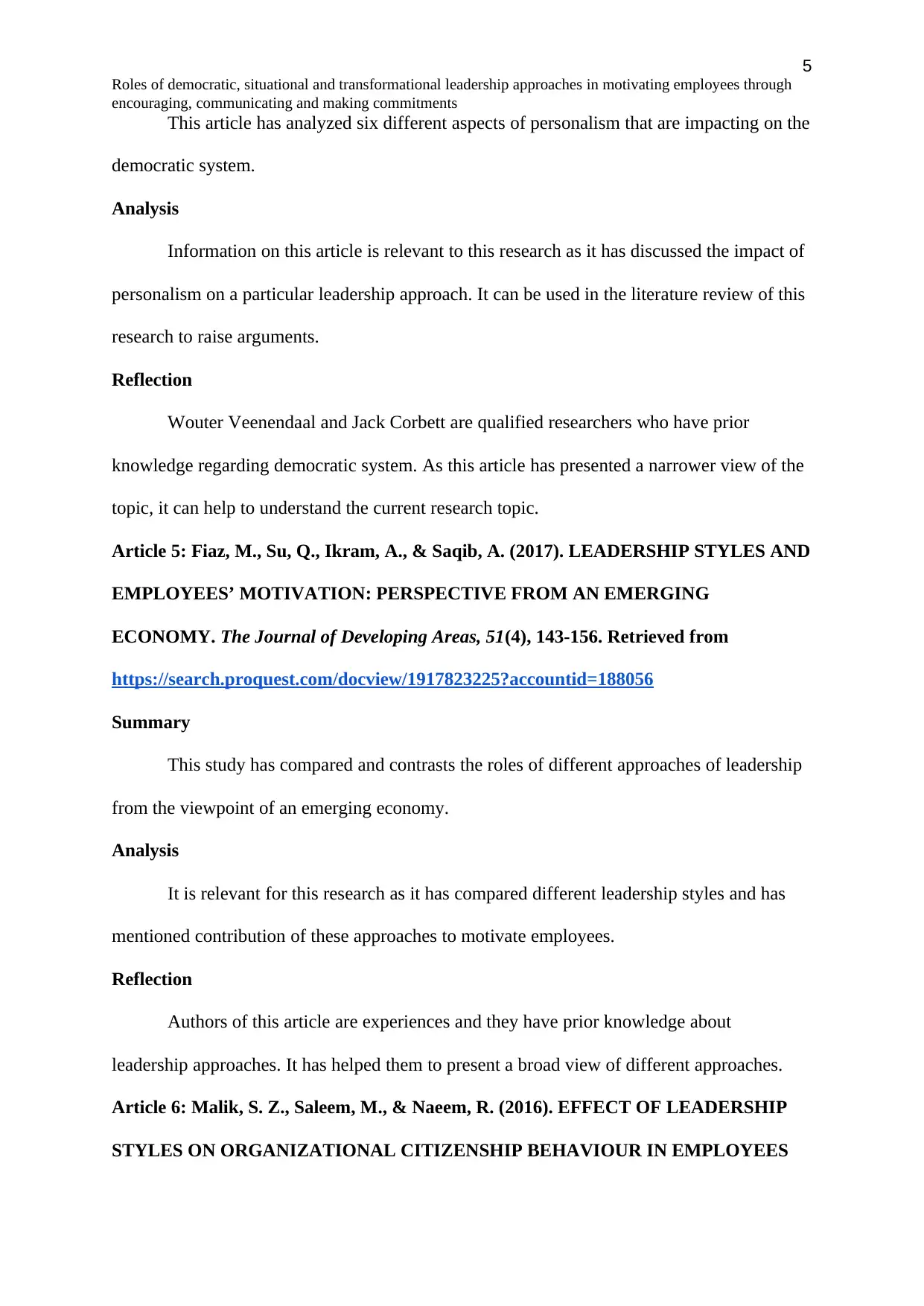
5
Roles of democratic, situational and transformational leadership approaches in motivating employees through
encouraging, communicating and making commitments
This article has analyzed six different aspects of personalism that are impacting on the
democratic system.
Analysis
Information on this article is relevant to this research as it has discussed the impact of
personalism on a particular leadership approach. It can be used in the literature review of this
research to raise arguments.
Reflection
Wouter Veenendaal and Jack Corbett are qualified researchers who have prior
knowledge regarding democratic system. As this article has presented a narrower view of the
topic, it can help to understand the current research topic.
Article 5: Fiaz, M., Su, Q., Ikram, A., & Saqib, A. (2017). LEADERSHIP STYLES AND
EMPLOYEES’ MOTIVATION: PERSPECTIVE FROM AN EMERGING
ECONOMY. The Journal of Developing Areas, 51(4), 143-156. Retrieved from
https://search.proquest.com/docview/1917823225?accountid=188056
Summary
This study has compared and contrasts the roles of different approaches of leadership
from the viewpoint of an emerging economy.
Analysis
It is relevant for this research as it has compared different leadership styles and has
mentioned contribution of these approaches to motivate employees.
Reflection
Authors of this article are experiences and they have prior knowledge about
leadership approaches. It has helped them to present a broad view of different approaches.
Article 6: Malik, S. Z., Saleem, M., & Naeem, R. (2016). EFFECT OF LEADERSHIP
STYLES ON ORGANIZATIONAL CITIZENSHIP BEHAVIOUR IN EMPLOYEES
Roles of democratic, situational and transformational leadership approaches in motivating employees through
encouraging, communicating and making commitments
This article has analyzed six different aspects of personalism that are impacting on the
democratic system.
Analysis
Information on this article is relevant to this research as it has discussed the impact of
personalism on a particular leadership approach. It can be used in the literature review of this
research to raise arguments.
Reflection
Wouter Veenendaal and Jack Corbett are qualified researchers who have prior
knowledge regarding democratic system. As this article has presented a narrower view of the
topic, it can help to understand the current research topic.
Article 5: Fiaz, M., Su, Q., Ikram, A., & Saqib, A. (2017). LEADERSHIP STYLES AND
EMPLOYEES’ MOTIVATION: PERSPECTIVE FROM AN EMERGING
ECONOMY. The Journal of Developing Areas, 51(4), 143-156. Retrieved from
https://search.proquest.com/docview/1917823225?accountid=188056
Summary
This study has compared and contrasts the roles of different approaches of leadership
from the viewpoint of an emerging economy.
Analysis
It is relevant for this research as it has compared different leadership styles and has
mentioned contribution of these approaches to motivate employees.
Reflection
Authors of this article are experiences and they have prior knowledge about
leadership approaches. It has helped them to present a broad view of different approaches.
Article 6: Malik, S. Z., Saleem, M., & Naeem, R. (2016). EFFECT OF LEADERSHIP
STYLES ON ORGANIZATIONAL CITIZENSHIP BEHAVIOUR IN EMPLOYEES
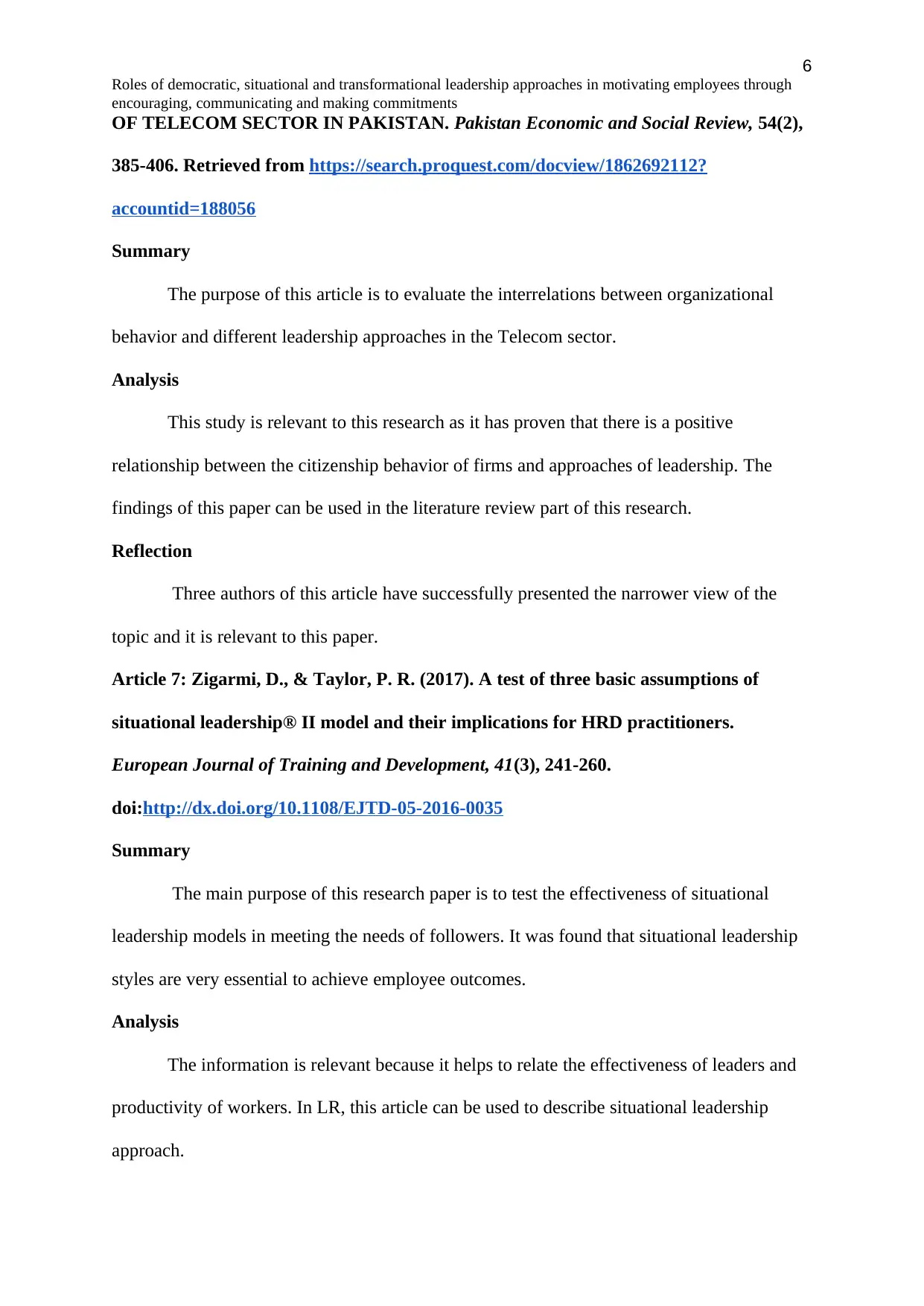
6
Roles of democratic, situational and transformational leadership approaches in motivating employees through
encouraging, communicating and making commitments
OF TELECOM SECTOR IN PAKISTAN. Pakistan Economic and Social Review, 54(2),
385-406. Retrieved from https://search.proquest.com/docview/1862692112?
accountid=188056
Summary
The purpose of this article is to evaluate the interrelations between organizational
behavior and different leadership approaches in the Telecom sector.
Analysis
This study is relevant to this research as it has proven that there is a positive
relationship between the citizenship behavior of firms and approaches of leadership. The
findings of this paper can be used in the literature review part of this research.
Reflection
Three authors of this article have successfully presented the narrower view of the
topic and it is relevant to this paper.
Article 7: Zigarmi, D., & Taylor, P. R. (2017). A test of three basic assumptions of
situational leadership® II model and their implications for HRD practitioners.
European Journal of Training and Development, 41(3), 241-260.
doi:http://dx.doi.org/10.1108/EJTD-05-2016-0035
Summary
The main purpose of this research paper is to test the effectiveness of situational
leadership models in meeting the needs of followers. It was found that situational leadership
styles are very essential to achieve employee outcomes.
Analysis
The information is relevant because it helps to relate the effectiveness of leaders and
productivity of workers. In LR, this article can be used to describe situational leadership
approach.
Roles of democratic, situational and transformational leadership approaches in motivating employees through
encouraging, communicating and making commitments
OF TELECOM SECTOR IN PAKISTAN. Pakistan Economic and Social Review, 54(2),
385-406. Retrieved from https://search.proquest.com/docview/1862692112?
accountid=188056
Summary
The purpose of this article is to evaluate the interrelations between organizational
behavior and different leadership approaches in the Telecom sector.
Analysis
This study is relevant to this research as it has proven that there is a positive
relationship between the citizenship behavior of firms and approaches of leadership. The
findings of this paper can be used in the literature review part of this research.
Reflection
Three authors of this article have successfully presented the narrower view of the
topic and it is relevant to this paper.
Article 7: Zigarmi, D., & Taylor, P. R. (2017). A test of three basic assumptions of
situational leadership® II model and their implications for HRD practitioners.
European Journal of Training and Development, 41(3), 241-260.
doi:http://dx.doi.org/10.1108/EJTD-05-2016-0035
Summary
The main purpose of this research paper is to test the effectiveness of situational
leadership models in meeting the needs of followers. It was found that situational leadership
styles are very essential to achieve employee outcomes.
Analysis
The information is relevant because it helps to relate the effectiveness of leaders and
productivity of workers. In LR, this article can be used to describe situational leadership
approach.
⊘ This is a preview!⊘
Do you want full access?
Subscribe today to unlock all pages.

Trusted by 1+ million students worldwide
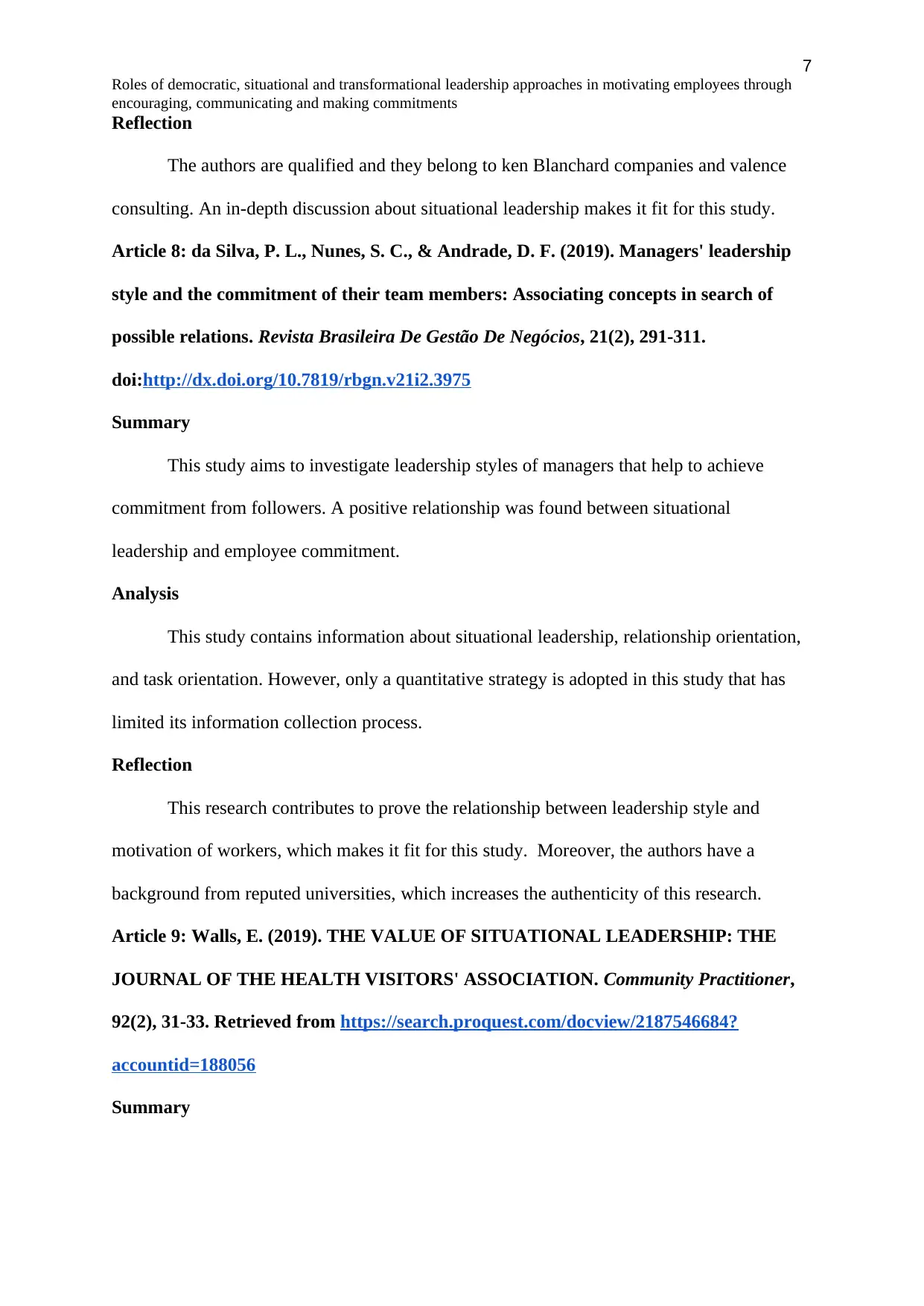
7
Roles of democratic, situational and transformational leadership approaches in motivating employees through
encouraging, communicating and making commitments
Reflection
The authors are qualified and they belong to ken Blanchard companies and valence
consulting. An in-depth discussion about situational leadership makes it fit for this study.
Article 8: da Silva, P. L., Nunes, S. C., & Andrade, D. F. (2019). Managers' leadership
style and the commitment of their team members: Associating concepts in search of
possible relations. Revista Brasileira De Gestão De Negócios, 21(2), 291-311.
doi:http://dx.doi.org/10.7819/rbgn.v21i2.3975
Summary
This study aims to investigate leadership styles of managers that help to achieve
commitment from followers. A positive relationship was found between situational
leadership and employee commitment.
Analysis
This study contains information about situational leadership, relationship orientation,
and task orientation. However, only a quantitative strategy is adopted in this study that has
limited its information collection process.
Reflection
This research contributes to prove the relationship between leadership style and
motivation of workers, which makes it fit for this study. Moreover, the authors have a
background from reputed universities, which increases the authenticity of this research.
Article 9: Walls, E. (2019). THE VALUE OF SITUATIONAL LEADERSHIP: THE
JOURNAL OF THE HEALTH VISITORS' ASSOCIATION. Community Practitioner,
92(2), 31-33. Retrieved from https://search.proquest.com/docview/2187546684?
accountid=188056
Summary
Roles of democratic, situational and transformational leadership approaches in motivating employees through
encouraging, communicating and making commitments
Reflection
The authors are qualified and they belong to ken Blanchard companies and valence
consulting. An in-depth discussion about situational leadership makes it fit for this study.
Article 8: da Silva, P. L., Nunes, S. C., & Andrade, D. F. (2019). Managers' leadership
style and the commitment of their team members: Associating concepts in search of
possible relations. Revista Brasileira De Gestão De Negócios, 21(2), 291-311.
doi:http://dx.doi.org/10.7819/rbgn.v21i2.3975
Summary
This study aims to investigate leadership styles of managers that help to achieve
commitment from followers. A positive relationship was found between situational
leadership and employee commitment.
Analysis
This study contains information about situational leadership, relationship orientation,
and task orientation. However, only a quantitative strategy is adopted in this study that has
limited its information collection process.
Reflection
This research contributes to prove the relationship between leadership style and
motivation of workers, which makes it fit for this study. Moreover, the authors have a
background from reputed universities, which increases the authenticity of this research.
Article 9: Walls, E. (2019). THE VALUE OF SITUATIONAL LEADERSHIP: THE
JOURNAL OF THE HEALTH VISITORS' ASSOCIATION. Community Practitioner,
92(2), 31-33. Retrieved from https://search.proquest.com/docview/2187546684?
accountid=188056
Summary
Paraphrase This Document
Need a fresh take? Get an instant paraphrase of this document with our AI Paraphraser

8
Roles of democratic, situational and transformational leadership approaches in motivating employees through
encouraging, communicating and making commitments
This article is about discussing the value of situational leadership. Different benefits
of situational leadership are mentioned in this article.
Analysis
The source of this article is a community practitioner and it has detailed information
about leadership styles that can improve knowledge level. In LR, this article will be used to
evaluate the approach of situational leadership.
Reflection
The author is highly qualified and she is a university lecturer. The source gets fits
with the topic because the motivation needs of the worker community can be known by
evaluating this article.
Article 10: Perna, B. S. (2016). Exploring situational leadership in quick service
restaurants. Journal of Business Studies Quarterly, 8(2), 1-6. Retrieved from
https://search.proquest.com/docview/1865707997?accountid=188056
Summary
This research is based on exploring situational leadership in the service industry. It
has been identified that this approach helps to improve leadership experiences in
organizational settings.
Analysis
The information is relevant because in this study the objective is to discuss the
effectiveness of leadership approaches in the service industry. In LR, the findings of this
article will be used to discuss the relationship between situational leadership and service
industry effectiveness.
Reflection
The source is helpful and is totally fit for this research because it can help to increase
understanding about the current study areas.
Roles of democratic, situational and transformational leadership approaches in motivating employees through
encouraging, communicating and making commitments
This article is about discussing the value of situational leadership. Different benefits
of situational leadership are mentioned in this article.
Analysis
The source of this article is a community practitioner and it has detailed information
about leadership styles that can improve knowledge level. In LR, this article will be used to
evaluate the approach of situational leadership.
Reflection
The author is highly qualified and she is a university lecturer. The source gets fits
with the topic because the motivation needs of the worker community can be known by
evaluating this article.
Article 10: Perna, B. S. (2016). Exploring situational leadership in quick service
restaurants. Journal of Business Studies Quarterly, 8(2), 1-6. Retrieved from
https://search.proquest.com/docview/1865707997?accountid=188056
Summary
This research is based on exploring situational leadership in the service industry. It
has been identified that this approach helps to improve leadership experiences in
organizational settings.
Analysis
The information is relevant because in this study the objective is to discuss the
effectiveness of leadership approaches in the service industry. In LR, the findings of this
article will be used to discuss the relationship between situational leadership and service
industry effectiveness.
Reflection
The source is helpful and is totally fit for this research because it can help to increase
understanding about the current study areas.
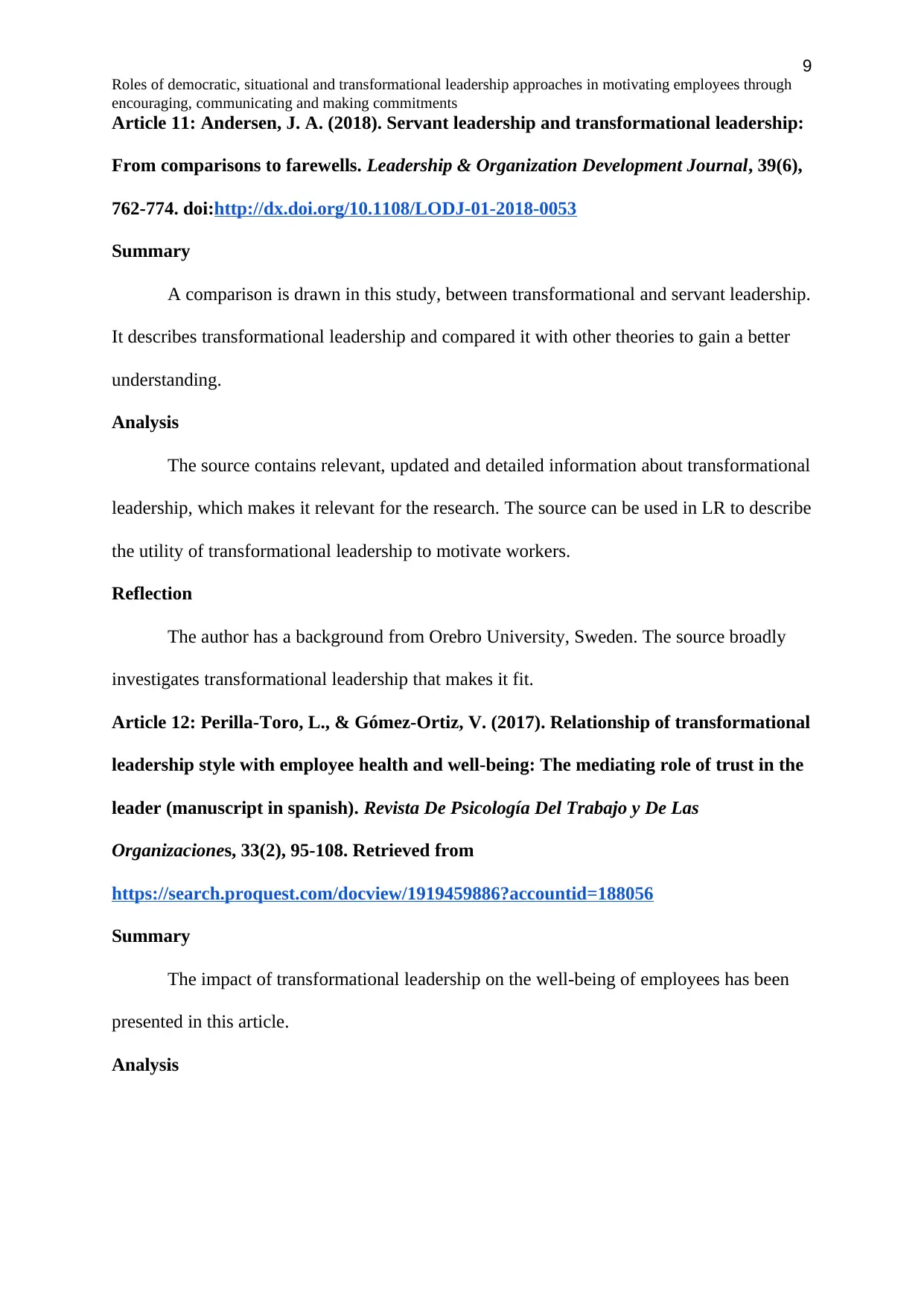
9
Roles of democratic, situational and transformational leadership approaches in motivating employees through
encouraging, communicating and making commitments
Article 11: Andersen, J. A. (2018). Servant leadership and transformational leadership:
From comparisons to farewells. Leadership & Organization Development Journal, 39(6),
762-774. doi:http://dx.doi.org/10.1108/LODJ-01-2018-0053
Summary
A comparison is drawn in this study, between transformational and servant leadership.
It describes transformational leadership and compared it with other theories to gain a better
understanding.
Analysis
The source contains relevant, updated and detailed information about transformational
leadership, which makes it relevant for the research. The source can be used in LR to describe
the utility of transformational leadership to motivate workers.
Reflection
The author has a background from Orebro University, Sweden. The source broadly
investigates transformational leadership that makes it fit.
Article 12: Perilla-Toro, L., & Gómez-Ortiz, V. (2017). Relationship of transformational
leadership style with employee health and well-being: The mediating role of trust in the
leader (manuscript in spanish). Revista De Psicología Del Trabajo y De Las
Organizaciones, 33(2), 95-108. Retrieved from
https://search.proquest.com/docview/1919459886?accountid=188056
Summary
The impact of transformational leadership on the well-being of employees has been
presented in this article.
Analysis
Roles of democratic, situational and transformational leadership approaches in motivating employees through
encouraging, communicating and making commitments
Article 11: Andersen, J. A. (2018). Servant leadership and transformational leadership:
From comparisons to farewells. Leadership & Organization Development Journal, 39(6),
762-774. doi:http://dx.doi.org/10.1108/LODJ-01-2018-0053
Summary
A comparison is drawn in this study, between transformational and servant leadership.
It describes transformational leadership and compared it with other theories to gain a better
understanding.
Analysis
The source contains relevant, updated and detailed information about transformational
leadership, which makes it relevant for the research. The source can be used in LR to describe
the utility of transformational leadership to motivate workers.
Reflection
The author has a background from Orebro University, Sweden. The source broadly
investigates transformational leadership that makes it fit.
Article 12: Perilla-Toro, L., & Gómez-Ortiz, V. (2017). Relationship of transformational
leadership style with employee health and well-being: The mediating role of trust in the
leader (manuscript in spanish). Revista De Psicología Del Trabajo y De Las
Organizaciones, 33(2), 95-108. Retrieved from
https://search.proquest.com/docview/1919459886?accountid=188056
Summary
The impact of transformational leadership on the well-being of employees has been
presented in this article.
Analysis
⊘ This is a preview!⊘
Do you want full access?
Subscribe today to unlock all pages.

Trusted by 1+ million students worldwide
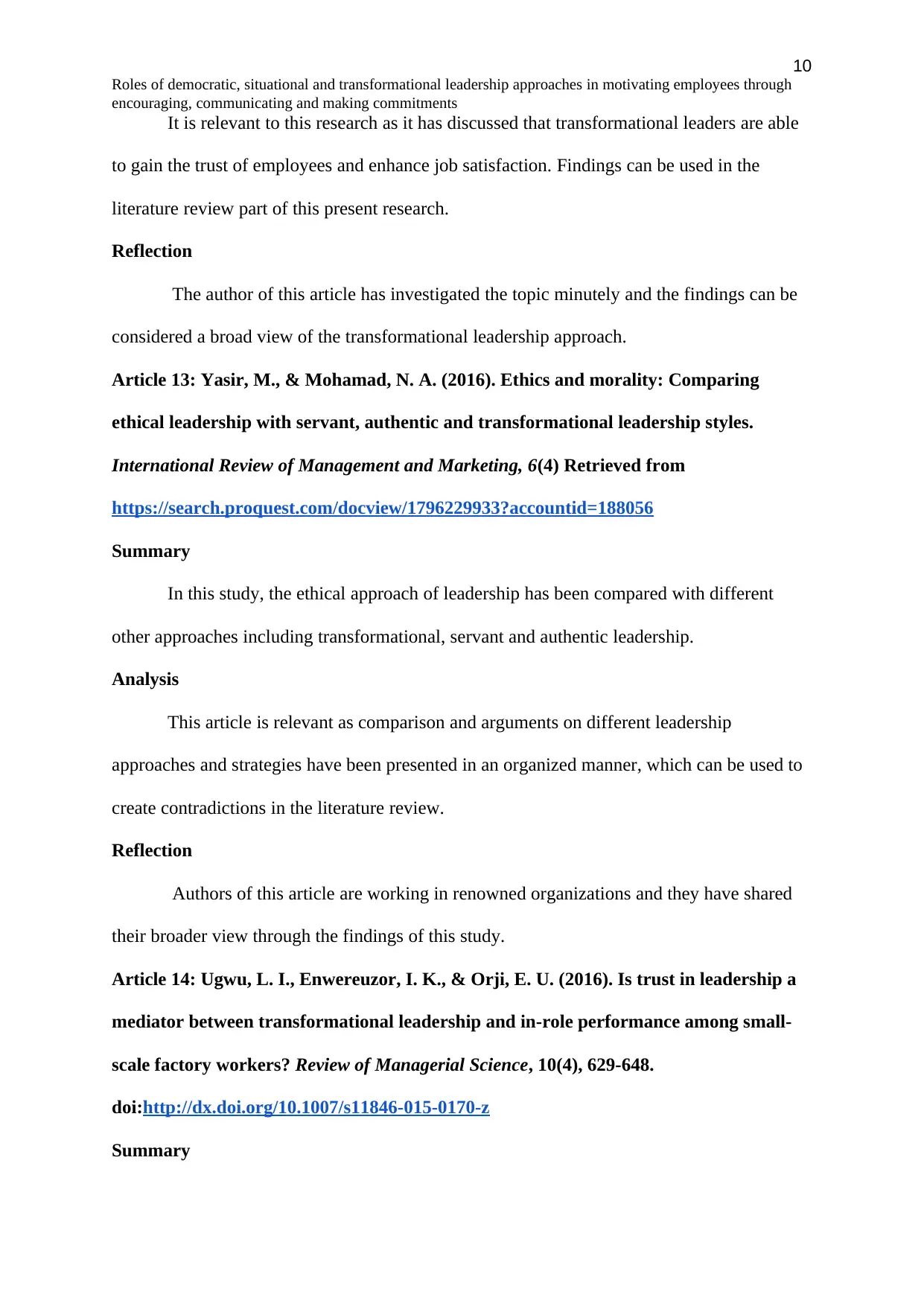
10
Roles of democratic, situational and transformational leadership approaches in motivating employees through
encouraging, communicating and making commitments
It is relevant to this research as it has discussed that transformational leaders are able
to gain the trust of employees and enhance job satisfaction. Findings can be used in the
literature review part of this present research.
Reflection
The author of this article has investigated the topic minutely and the findings can be
considered a broad view of the transformational leadership approach.
Article 13: Yasir, M., & Mohamad, N. A. (2016). Ethics and morality: Comparing
ethical leadership with servant, authentic and transformational leadership styles.
International Review of Management and Marketing, 6(4) Retrieved from
https://search.proquest.com/docview/1796229933?accountid=188056
Summary
In this study, the ethical approach of leadership has been compared with different
other approaches including transformational, servant and authentic leadership.
Analysis
This article is relevant as comparison and arguments on different leadership
approaches and strategies have been presented in an organized manner, which can be used to
create contradictions in the literature review.
Reflection
Authors of this article are working in renowned organizations and they have shared
their broader view through the findings of this study.
Article 14: Ugwu, L. I., Enwereuzor, I. K., & Orji, E. U. (2016). Is trust in leadership a
mediator between transformational leadership and in-role performance among small-
scale factory workers? Review of Managerial Science, 10(4), 629-648.
doi:http://dx.doi.org/10.1007/s11846-015-0170-z
Summary
Roles of democratic, situational and transformational leadership approaches in motivating employees through
encouraging, communicating and making commitments
It is relevant to this research as it has discussed that transformational leaders are able
to gain the trust of employees and enhance job satisfaction. Findings can be used in the
literature review part of this present research.
Reflection
The author of this article has investigated the topic minutely and the findings can be
considered a broad view of the transformational leadership approach.
Article 13: Yasir, M., & Mohamad, N. A. (2016). Ethics and morality: Comparing
ethical leadership with servant, authentic and transformational leadership styles.
International Review of Management and Marketing, 6(4) Retrieved from
https://search.proquest.com/docview/1796229933?accountid=188056
Summary
In this study, the ethical approach of leadership has been compared with different
other approaches including transformational, servant and authentic leadership.
Analysis
This article is relevant as comparison and arguments on different leadership
approaches and strategies have been presented in an organized manner, which can be used to
create contradictions in the literature review.
Reflection
Authors of this article are working in renowned organizations and they have shared
their broader view through the findings of this study.
Article 14: Ugwu, L. I., Enwereuzor, I. K., & Orji, E. U. (2016). Is trust in leadership a
mediator between transformational leadership and in-role performance among small-
scale factory workers? Review of Managerial Science, 10(4), 629-648.
doi:http://dx.doi.org/10.1007/s11846-015-0170-z
Summary
Paraphrase This Document
Need a fresh take? Get an instant paraphrase of this document with our AI Paraphraser
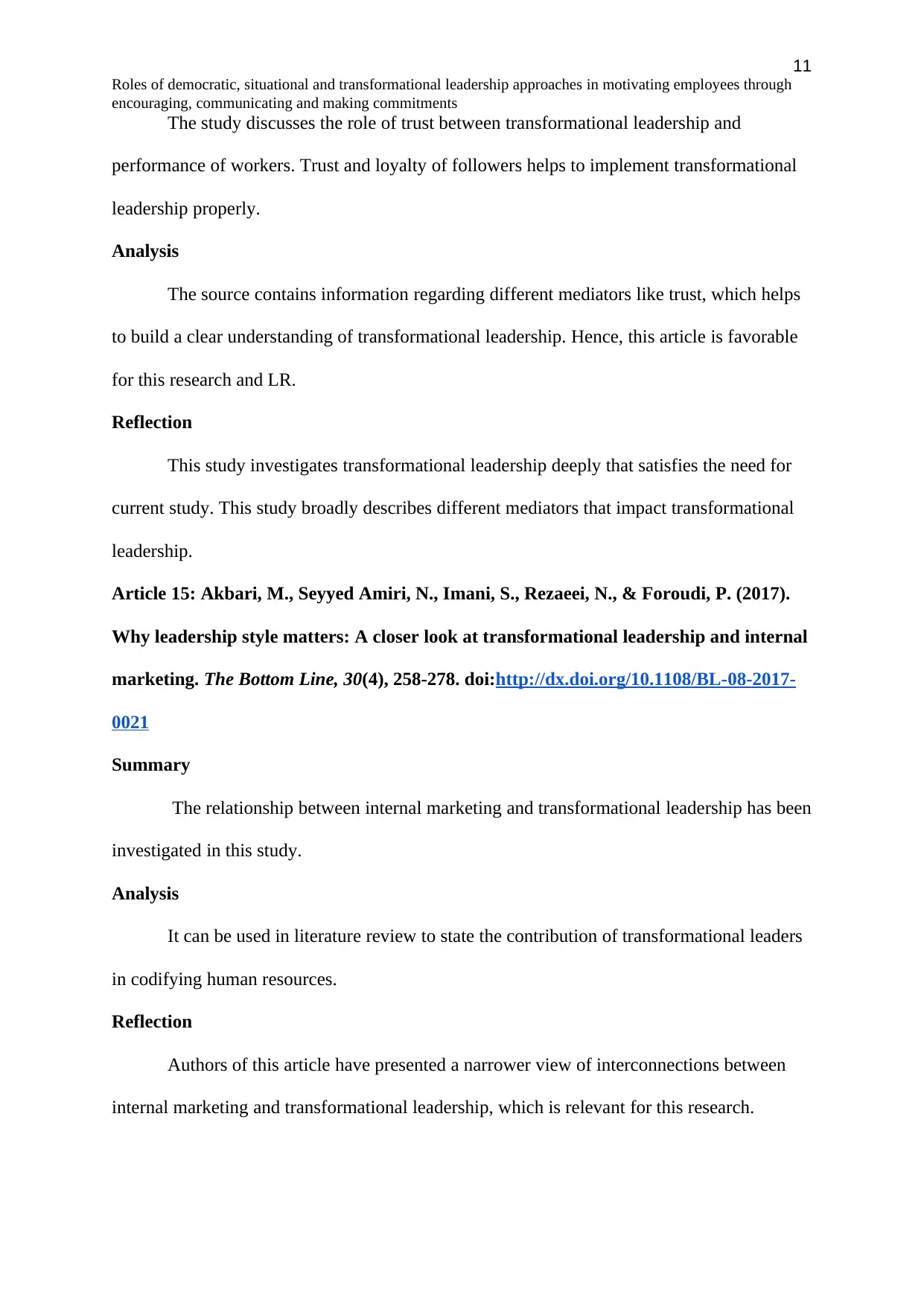
11
Roles of democratic, situational and transformational leadership approaches in motivating employees through
encouraging, communicating and making commitments
The study discusses the role of trust between transformational leadership and
performance of workers. Trust and loyalty of followers helps to implement transformational
leadership properly.
Analysis
The source contains information regarding different mediators like trust, which helps
to build a clear understanding of transformational leadership. Hence, this article is favorable
for this research and LR.
Reflection
This study investigates transformational leadership deeply that satisfies the need for
current study. This study broadly describes different mediators that impact transformational
leadership.
Article 15: Akbari, M., Seyyed Amiri, N., Imani, S., Rezaeei, N., & Foroudi, P. (2017).
Why leadership style matters: A closer look at transformational leadership and internal
marketing. The Bottom Line, 30(4), 258-278. doi:http://dx.doi.org/10.1108/BL-08-2017-
0021
Summary
The relationship between internal marketing and transformational leadership has been
investigated in this study.
Analysis
It can be used in literature review to state the contribution of transformational leaders
in codifying human resources.
Reflection
Authors of this article have presented a narrower view of interconnections between
internal marketing and transformational leadership, which is relevant for this research.
Roles of democratic, situational and transformational leadership approaches in motivating employees through
encouraging, communicating and making commitments
The study discusses the role of trust between transformational leadership and
performance of workers. Trust and loyalty of followers helps to implement transformational
leadership properly.
Analysis
The source contains information regarding different mediators like trust, which helps
to build a clear understanding of transformational leadership. Hence, this article is favorable
for this research and LR.
Reflection
This study investigates transformational leadership deeply that satisfies the need for
current study. This study broadly describes different mediators that impact transformational
leadership.
Article 15: Akbari, M., Seyyed Amiri, N., Imani, S., Rezaeei, N., & Foroudi, P. (2017).
Why leadership style matters: A closer look at transformational leadership and internal
marketing. The Bottom Line, 30(4), 258-278. doi:http://dx.doi.org/10.1108/BL-08-2017-
0021
Summary
The relationship between internal marketing and transformational leadership has been
investigated in this study.
Analysis
It can be used in literature review to state the contribution of transformational leaders
in codifying human resources.
Reflection
Authors of this article have presented a narrower view of interconnections between
internal marketing and transformational leadership, which is relevant for this research.
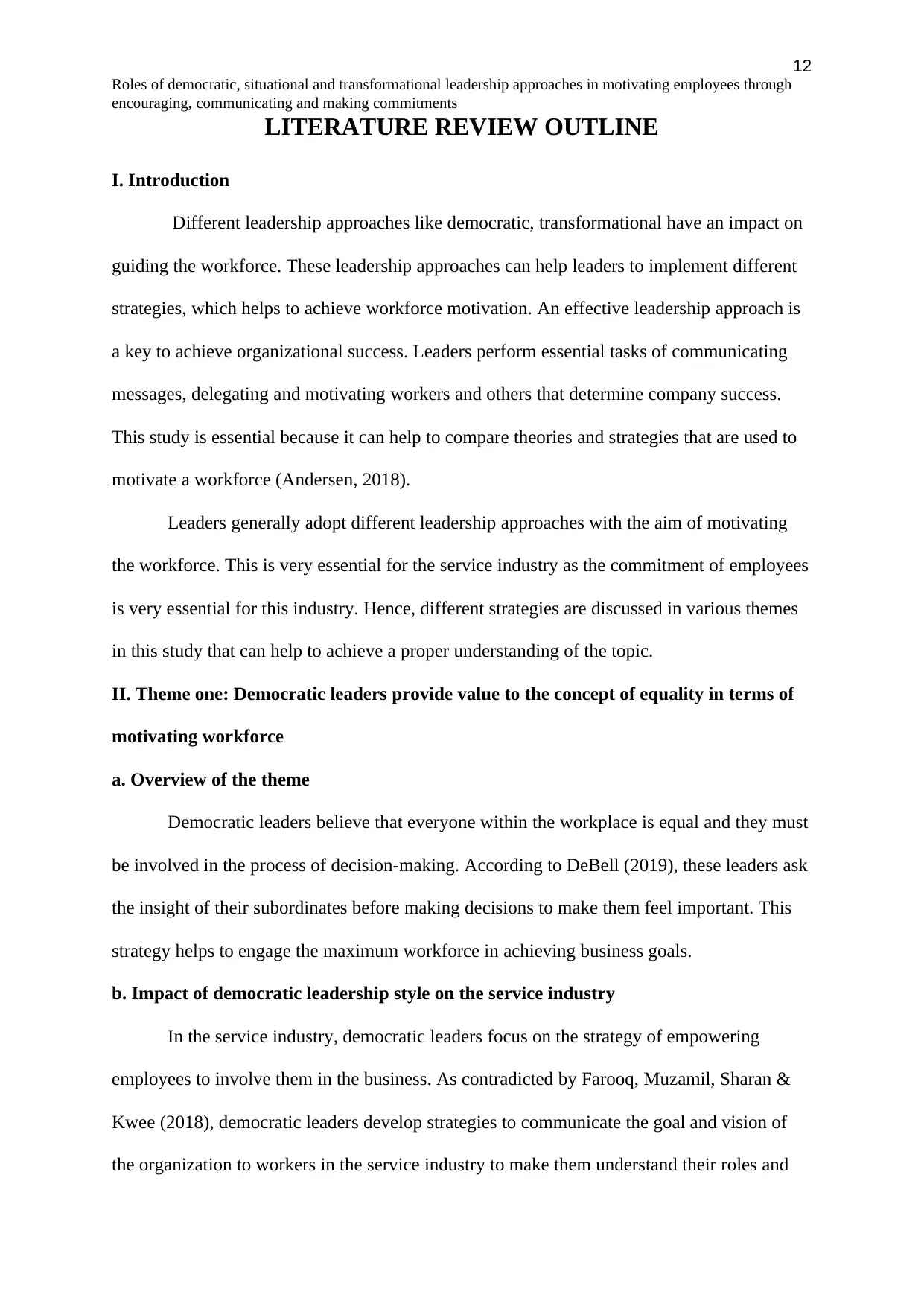
12
Roles of democratic, situational and transformational leadership approaches in motivating employees through
encouraging, communicating and making commitments
LITERATURE REVIEW OUTLINE
I. Introduction
Different leadership approaches like democratic, transformational have an impact on
guiding the workforce. These leadership approaches can help leaders to implement different
strategies, which helps to achieve workforce motivation. An effective leadership approach is
a key to achieve organizational success. Leaders perform essential tasks of communicating
messages, delegating and motivating workers and others that determine company success.
This study is essential because it can help to compare theories and strategies that are used to
motivate a workforce (Andersen, 2018).
Leaders generally adopt different leadership approaches with the aim of motivating
the workforce. This is very essential for the service industry as the commitment of employees
is very essential for this industry. Hence, different strategies are discussed in various themes
in this study that can help to achieve a proper understanding of the topic.
II. Theme one: Democratic leaders provide value to the concept of equality in terms of
motivating workforce
a. Overview of the theme
Democratic leaders believe that everyone within the workplace is equal and they must
be involved in the process of decision-making. According to DeBell (2019), these leaders ask
the insight of their subordinates before making decisions to make them feel important. This
strategy helps to engage the maximum workforce in achieving business goals.
b. Impact of democratic leadership style on the service industry
In the service industry, democratic leaders focus on the strategy of empowering
employees to involve them in the business. As contradicted by Farooq, Muzamil, Sharan &
Kwee (2018), democratic leaders develop strategies to communicate the goal and vision of
the organization to workers in the service industry to make them understand their roles and
Roles of democratic, situational and transformational leadership approaches in motivating employees through
encouraging, communicating and making commitments
LITERATURE REVIEW OUTLINE
I. Introduction
Different leadership approaches like democratic, transformational have an impact on
guiding the workforce. These leadership approaches can help leaders to implement different
strategies, which helps to achieve workforce motivation. An effective leadership approach is
a key to achieve organizational success. Leaders perform essential tasks of communicating
messages, delegating and motivating workers and others that determine company success.
This study is essential because it can help to compare theories and strategies that are used to
motivate a workforce (Andersen, 2018).
Leaders generally adopt different leadership approaches with the aim of motivating
the workforce. This is very essential for the service industry as the commitment of employees
is very essential for this industry. Hence, different strategies are discussed in various themes
in this study that can help to achieve a proper understanding of the topic.
II. Theme one: Democratic leaders provide value to the concept of equality in terms of
motivating workforce
a. Overview of the theme
Democratic leaders believe that everyone within the workplace is equal and they must
be involved in the process of decision-making. According to DeBell (2019), these leaders ask
the insight of their subordinates before making decisions to make them feel important. This
strategy helps to engage the maximum workforce in achieving business goals.
b. Impact of democratic leadership style on the service industry
In the service industry, democratic leaders focus on the strategy of empowering
employees to involve them in the business. As contradicted by Farooq, Muzamil, Sharan &
Kwee (2018), democratic leaders develop strategies to communicate the goal and vision of
the organization to workers in the service industry to make them understand their roles and
⊘ This is a preview!⊘
Do you want full access?
Subscribe today to unlock all pages.

Trusted by 1+ million students worldwide
1 out of 18
Related Documents
Your All-in-One AI-Powered Toolkit for Academic Success.
+13062052269
info@desklib.com
Available 24*7 on WhatsApp / Email
![[object Object]](/_next/static/media/star-bottom.7253800d.svg)
Unlock your academic potential
Copyright © 2020–2025 A2Z Services. All Rights Reserved. Developed and managed by ZUCOL.





